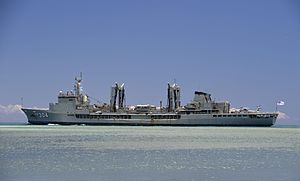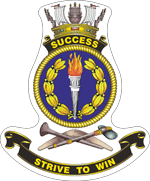HMAS Success (AOR-304)

HMAS Success in 2014
|
|
| History | |
|---|---|
|
|
|
| Builder: | Cockatoo Island Dockyard |
| Laid down: | 9 August 1980 |
| Launched: | 3 March 1984 |
| Commissioned: | 23 April 1986 |
| Homeport: | Fleet Base East, Sydney |
| Motto: | "Strive to Win" |
| Nickname(s): | Battle Tanker |
| Honours and awards: |
|
| Status: | Active as of 2016 |
| Badge: |  |
| General characteristics | |
| Class and type: | Durance-class replenishment oiler |
| Displacement: | 18,221 tonnes (full load) |
| Length: | 157.2 m (516 ft) |
| Beam: | 21.2 m (70 ft) |
| Draught: | 8.6 m (28 ft) |
| Propulsion: | 2 × SEMT-Pielstick 16 PC2.5 V 400 diesel engines, driving two shafts |
| Speed: | 20 knots (37 km/h; 23 mph) |
| Range: | 8,616 nmi (15,957 km) at 15 knots (28 km/h; 17 mph) |
| Boats & landing craft carried: |
1 × LCVP |
| Capacity: |
|
| Complement: | 25 officer, 212 sailors |
| Sensors and processing systems: |
2 × Kelvin Hughes Type 100G radars |
| Armament: |
|
| Aircraft carried: | 1 × helicopter (Sea King, Seahawk, or Squirrel) |
| Aviation facilities: | Aft hangar and helipad for single helicopter |
HMAS Success (OR 304) is a Durance-class multi-product replenishment oiler serving in the Royal Australian Navy (RAN). Built at Cockatoo Island Dockyard in Sydney, Australia, during the 1980s, she is the only ship of the class to be constructed outside France, and the only one to not originally serve in the Marine Nationale (French Navy). The ship was part of the Australian contribution to the 1991 Gulf War, and was deployed to East Timor in response to incidents in 1999 and 2006. The ship was fitted with a double hull during the first half of 2011, to meet International Maritime Organisation standards.
Seeing a need to replace the ageing oiler HMAS Supply, the RAN placed an order in 1971 for a combat support ship-a replenishment vessel capable of supplying ammunition and stores in addition to fuel-to be named HMAS Protector. However, concerns about the cost of construction prompted the order's cancellation in 1974. Instead, the Directions Techniques Des Constructions Navales was approached about constructing a Durance-class replenishment oiler for the RAN, and a design contract was awarded to the Government of France in 1977. The $68.4 million (in 1978 prices) construction contract was awarded to Vickers Cockatoo Dockyard in October 1979, with ship delivery by 31 July 1983.
The modified Durance-class oiler is 157.2 metres (516 ft) in length, with a beam of 21.2 metres (70 ft), and a draught of 8.6 metres (28 ft), with a full load displacement of 18,221 tonnes. Propulsion machinery consists of two SEMT-Pielstick 16 PC2.5 V 400 diesel motors, which supply 20,800 horsepower (15,500 kW) to the ship's two propeller shafts. Top speed is 20 knots (37 km/h; 23 mph), and the ship has a range of 8,616 nautical miles (15,957 km; 9,915 mi) at 15 knots (28 km/h; 17 mph).Success has a total capacity of 10,200 tonnes of cargo: 8,707 tonnes of diesel fuel, 975 tonnes of aviation fuel, 250 tonnes of munitions (including guided missiles and torpedoes), 116 tonnes of water, 95 tonnes of components and naval stores, and 57 tonnes of food and other consumables. Fuel and liquid stores can be transferred from four points (two on each side), allowing Success to replenish two ships simultaneously, while solid cargo can be moved via vertical replenishment (with a hangar and helipad for a single Sea King, Seahawk, or Squirrel helicopter), or by boat (the RAN LCVP T 7 is carried on a starboard FWD davit). The ship is armed with seven 12.7 mm machine guns, and is fitted for but not with a Mark 15 Phalanx CIWS. The sensor suite includes two Kelvin Hughes Type 100G navigation radars. Ship's company is made up of 25 officers and 212 sailors.
...
Wikipedia
